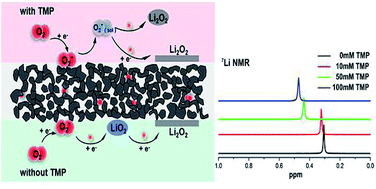Tetramethylpyrazine: an electrolyte additive for high capacity and energy efficiency lithium–oxygen batteries†
Abstract
Lithium–oxygen batteries have attracted great attention in recent years owing to their extremely high theoretical energy density, however, factors such as low actual capacity and poor rate performance hinder the practical application of lithium–oxygen batteries. In this work, a novel electrolyte additive, tetramethylpyrazine (TMP), is introduced into an electrolyte system to enhance the electrochemical performance of the lithium–oxygen batteries. TMP does not undergo its own redox reaction within the charge–discharge voltage range, which will not affect the electrochemical stability of the electrolyte. The results show that the addition of TMP can increase the reduction current of oxygen, which will promote the ORR process, and with an optimal TMP content (50 mM), the cell shows a high discharge capacity of 5712.3 mA h g−1 at 0.1 mA cm−2. And its rate capability is almost doubled compared with the system without TMP additive at a large current density of 1 mA cm−2. Further analysis by SEM and XRD reveals that the addition of TMP can reduce the formation of by-products and promote the solution growth of large-size Li2O2 particles to achieve a large discharge capacity. This approach could provide a new idea for improving the electrochemical performance of lithium–oxygen batteries.



 Please wait while we load your content...
Please wait while we load your content...